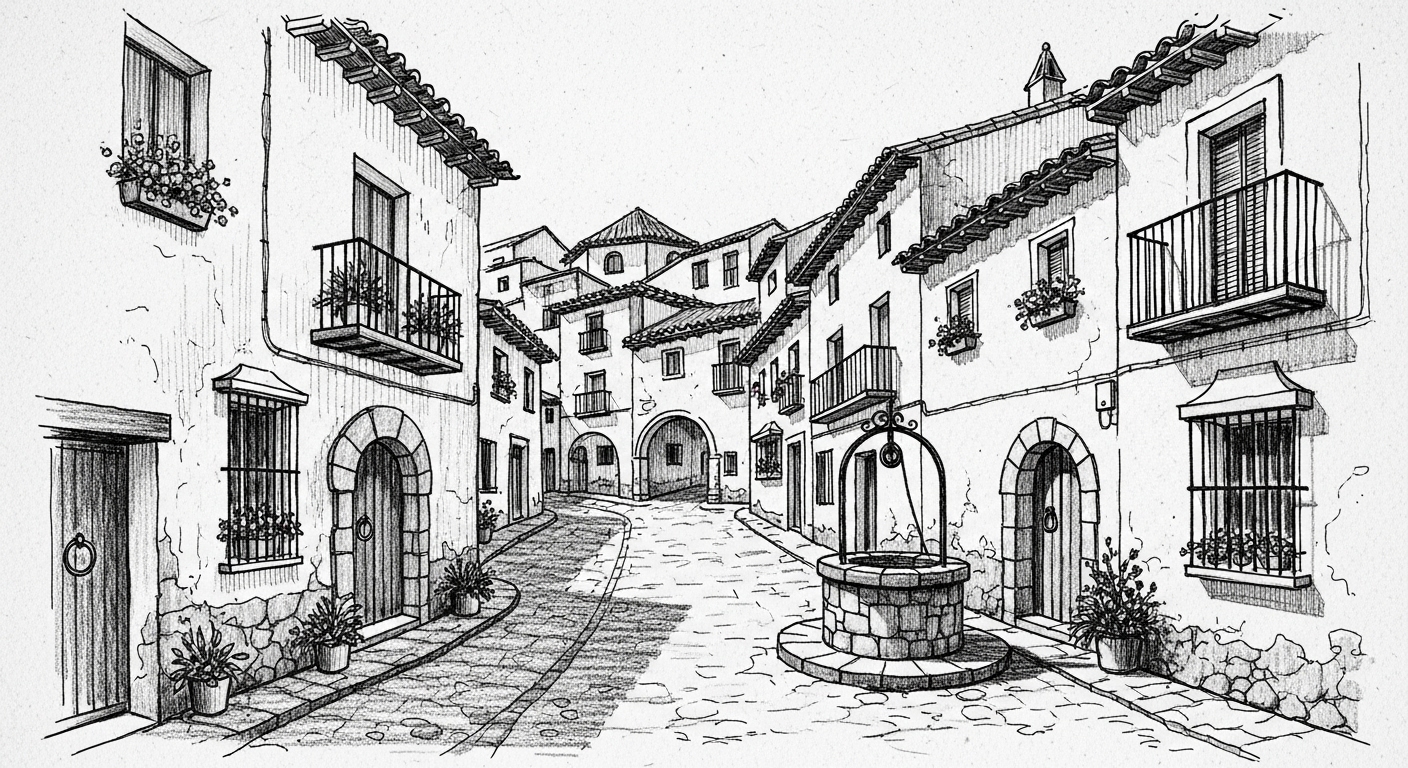Your Spanish Nouns and Adjectives Aren't Friends Yet. Here's How to Introduce Them.

You’ve done the work. You’ve memorized your first 50 Spanish nouns and a handful of useful adjectives. You feel a surge of confidence. You know coche (car), casa (house), and the color rojo (red). Today’s the day you’ll form a real sentence!
So you try to say, “the red house.”
Is it la casa rojo? Or el casa roja? Maybe la casa roja? 🤔
Suddenly, what seemed simple feels like a complex puzzle. That confident feeling evaporates, replaced by hesitation. If you can’t get this right, how will you ever build more complex sentences?
This is one of the first major hurdles for every single beginner Spanish learner. It’s the moment you realize that knowing words isn’t enough; you need to know how they work together. The good news is that this concept, called adjective agreement, isn’t as scary as it looks. It has rules, and once you see the pattern, you’ll never be able to unsee it.
This guide will walk you through it - not with complicated charts, but with a simple mental model that will make your nouns and adjectives click.
The Core Idea: Spanish Adjectives are Like Chameleons 🦎
In English, adjectives are simple. We say “a tall man,” “a tall woman,” “the tall children.” The word “tall” never changes. It’s reliable and predictable.
In Spanish, adjectives are more like chameleons: they change their appearance to match their surroundings. The “surroundings” in this case are the noun they describe. Every noun in Spanish has two key properties you need to know:
- Gender: It’s either masculine or feminine.
- Number: It’s either singular or plural.
The adjective’s job is to change its ending to match the gender and number of the noun it’s describing. This is “agreement.”
Let’s see it in action with the adjective alto (tall):
- Masculine Singular:
el chico alto(the tall boy) - Feminine Singular:
la chica alta(the tall girl) - Masculine Plural:
los chicos altos(the tall boys) - Feminine Plural:
las chicas altas(the tall girls)
See the pattern? The adjective alto changed its ending four different times to perfectly match the noun. This might seem like a lot of work, but it’s governed by a few very dependable rules.
The Two Golden Rules for Spanish Adjective Endings
For 90% of situations you’ll encounter as a beginner, you only need to know two main patterns.
Golden Rule #1: The -o / -a Gender Swap
This is the most common pattern and the easiest one to master.
If an adjective’s default form (the one you find in the dictionary) ends in -o, it’s masculine. To make it feminine, you simply change the -o to an -a.
That’s it. Let’s look at some examples:
rojo(red) ->el coche rojo(m) vs.la manzana roja(f)bonito(pretty) ->el pueblo bonito(m) vs.la flor bonita(f)nuevo(new) ->el libro nuevo(m) vs.la casa nueva(f)pequeño(small) ->el perro pequeño(m) vs.la mesa pequeña(f)
Once you start seeing this -o/-a swap, you’ll notice it everywhere. It’s the fundamental rhythm of Spanish descriptions.
Golden Rule #2: The Plural Rule (Just Add -s or -es)
Making adjectives plural is also very straightforward.
- If the adjective ends in a vowel (
-o,-a,-e), just add an-s.rojo->rojosroja->rojasgrande->grandes
- If the adjective ends in a consonant, just add
-es.fácil->fácilespopular->populares
Let’s combine our two rules. We want to say “the pretty flowers” (la flor is feminine).
- Start with
bonito. floris feminine, sobonitobecomesbonita.- We want plural “flowers” (
las flores), sobonitabecomesbonitas.
Result: las flores bonitas. You did it! ✅
What About the Other Adjectives? (The 'Neutrals')
“But what about adjectives like grande (big) or inteligente (intelligent)?” Great question! This is where many beginners get stuck.
The rule is simple: Most adjectives that don’t end in -o are neutral. They don’t change their form for masculine or feminine nouns.
un problema grande(a big problem - masculine)una ciudad grande(a big city - feminine)
See? grande stays the same. The same goes for adjectives ending in consonants:
un examen difícil(a difficult exam - masculine)una lección difícil(a difficult lesson - feminine)
However, they still need to agree in number. So when you make them plural, you follow Golden Rule #2:
los problemas grandeslas ciudades grandeslos exámenes difícileslas lecciones difíciles
So, to recap:
- Ends in
-o? Changes to-afor feminine. - Ends in
-eor a consonant? Stays the same for masculine/feminine. - Making it plural? Add
-sif it ends in a vowel,-esif it ends in a consonant.
The Method to Make it Stick: Look, Link, and Create
Knowing the rules is one thing. Making them an automatic part of your speech is another. You need to train your brain to see these connections instinctively. Here’s a simple, three-step process you can use every day.
1. Look (Active Reading): Don't just read Spanish text for meaning. Become a detective. Every time you see an adjective, find the noun it’s connected to. Literally draw a line between them on a piece of paper if you have to. Ask yourself: “Why does it end in
-ahere? Oh, becausemesais feminine.” This active observation builds the pattern in your mind.2. Link (Active Listening): When you listen to Spanish music or watch a show, listen for the sound of agreement. You'll hear the rhyming endings in phrases like
la casa blancaorel cielo azul. Linking the sound to the rule solidifies your understanding.3. Create (Active Production): This is the most crucial step. You must produce the language. Take a simple noun you know, like
el libro(the book). Now, attach adjectives to it.el libro es rojo.(The book is red.)el libro es interesante.(The book is interesting.)- Now make it plural:
los libros son rojos e interesantes.
This simple act of creating your own correct sentences is the single most effective way to move from knowing the grammar to using it.
The Problem: Practice is Hard and Feedback is Slow
The “Look, Link, and Create” method is incredibly effective, but it has a bottleneck. Finding enough level-appropriate reading material can be a chore. And when you create your own sentences, how do you know if you’re right? You can write “la problema grande” a hundred times, reinforcing a mistake without ever realizing it.
This is where technology can transform your learning from a slow, frustrating process into a rapid, rewarding cycle. Instead of guessing, you can get instant, expert-level feedback on every sentence you write.
This is precisely why we built Toritark. It’s designed to automate the “Look, Link, and Create” cycle for you.
Step 1: Endless Content to “Look” At (AI Story Generation)
Instead of searching for A1-friendly articles, you tell Toritark what you’re interested in - maybe “a day at the market” or “my daily routine.” With one tap, our AI generates a unique, short story just for you, at your level. Now you have a perfect piece of text to see adjective agreement used naturally in context. You’ll see phrases like las verduras frescas (the fresh vegetables) and un mercado grande (a big market) used correctly.
Step 2: “Create” with Confidence and Get Instant Feedback
This is where the magic happens. After you read the story, Toritark prompts you to retell it in your own words. This is your chance to Create. You’ll try to use the new vocabulary and apply the grammar rules you’ve learned.
Let's say you write: Compré una manzana rojo.
You won’t have to wonder if it’s correct. The moment you submit your text, Toritark’s AI analyzes it and gives you incredible feedback. It won’t just say “wrong.” It will show you a side-by-side comparison:
- Your text:
Compré una manzana rojo. - Correction:
Compré una manzana roja. - Explanation: “The adjective
rojoshould berojato agree in gender with the feminine nounmanzana.”
This is like having a personal Spanish tutor available 24/7, catching your small mistakes before they become bad habits. It corrects your spelling, grammar, and even checks if you retold the story accurately.
Step 3: “Link” Vocabulary to Context, Forever
When you read a story and find a new word like fresco (fresh), you can save it. Later, Toritark’s vocabulary trainer doesn’t just show you a flashcard. It creates a fill-in-the-blank quiz using the exact sentence from the story where you found it:
En el mercado, las verduras eran muy _______. (frescas)
This forces you to recall the word and its correct adjective ending in the original context, cementing the grammar and the vocabulary at the same time.
Stop Guessing, Start Writing
Mastering Spanish adjective agreement is your first big step toward writing sentences that are not only understood but are also correct. It's about building a solid foundation.
You can absolutely do it with notebooks and dedication using the “Look, Link, and Create” method. But if you want to accelerate the process, eliminate the guesswork, and get the confidence that comes from instant feedback, a tool designed for this exact purpose can make all the difference.
Ready to stop feeling hesitant? Generate your first AI story on Toritark and write your first sentences with the confidence that you’re getting it right, every single time.
Finally, Speak with Confidence
📖 Read short stories adapted to your level.
✍️ Retell them & get instant AI corrections on your writing.
🧠 Master new words in their real context.
Similar posts

The Soul of Your Spanish Sentence: How ‘Ser’ vs. ‘Estar’ Changes Everything
Stop memorizing rules for 'ser' vs. 'estar'. Learn the single mental model that unlocks their true meaning and transforms your Spanish from robotic to natural. This is the key to descriptive storytelling.

Your Spanish Has Two Speeds: How to Switch from ‘Describing’ to ‘Doing’
Stuck between Spanish past tenses? This guide offers a new way to think about Preterite vs. Imperfect and Ser vs. Estar, helping you tell stories that flow naturally.

One Tiny Letter Is Breaking Your Spanish Sentences. Here's How to Fix It.
Struggling with 'el' vs 'la' or 'rojo' vs 'roja'? Discover why this one detail is the key to clear Spanish communication and how you can master it for good.

The 'Por' vs. 'Para' Puzzle: A Simple Mental Model to Finally Solve It
Stop guessing between 'por' and 'para'. Forget the confusing acronyms. Learn one simple mental framework that will make the right choice feel intuitive and natural.

The Secret 'Human' Switch in Your Spanish Sentences (And How to Flip It)
Discover the personal 'a', the simple Spanish grammar rule that beginners often miss. Learn why it exists, when to use it, and how to make it an instinct.